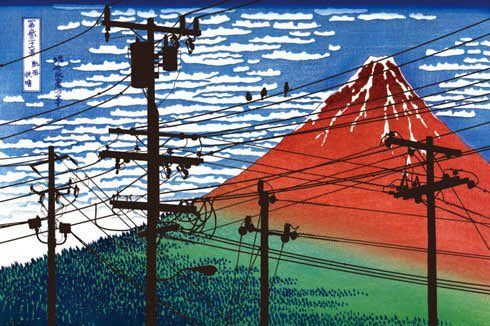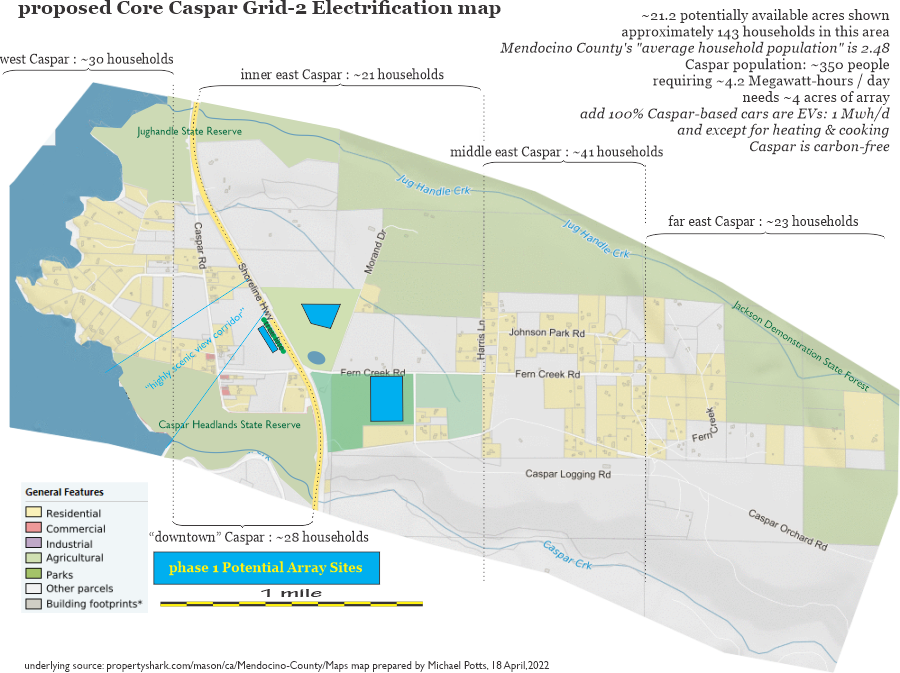Caspar: an Electric Island
Suppose Caspar could surge ahead and become electricity independent?
California, a wannabe leader in the effort to overcome global weirding, proposes to be carbon neutral in 20 years. (Note: that's what the head – the Governor – says, but the arms and legs – CalFire, CalTrans, the PUC, etc. – don't seem to be doing anything about it yet. THAT's our opportunity!) We the people will have to start someplace, and here where we live is curiously well suited to be the starting place.
Why here? Good sun, gorse-covered land suitable for use for photovoltaic generation (on the map at right, in the dark blue blocks), a willing utility with money in its pocket . . . and the overwhelming incentive that it will save us money in the reasonably short term.
Why us? Because we Casparados have shown an unusual capability to work together on a challenging project, build consensus, and execute.
And another thing (or two): electricity demand continues to increase, and as more of us drive EVs, it will accelerate. Current utility long lines, the four little feeders that power Caspar's grid, are barely adequate now. Utilities have been advised to expect a 300% increase in the next decades. Locally generated energy frees those long lines up for energy exchanges while reducing the total number of electrons being wastefully wheeled.
There are about 150 households in Caspar, and Mendocino County's 'average household population' is 2.48, so let's say there are about 350 people living in Caspar. Every Californian uses about 12 kilowatt-hours of electricity each day, so Caspar's consumption is about 4.2 Megawatt-hours per day. Current photovoltaic technology can produce that much energy using 4 acres of land. Caspar has at least 5 times that amount of favorably sited (sunny, somewhat south-facing) land, currently covered with invasive Gorse.
Most of us buy our electricty from Sonoma Clean Power (SCP), a forward-looking utility at the forefront of offering 'decarbonized' energy. In addition to their ability, as a blue-chip utility, to borrow, there are several early-adopter grants and funding sources available for exactly this kind of development: resiliency grants from the Coastal Commission, shovel-ready Grid-2 grants from the Federal Energy Agency. With our support, SCP is perfectly positioned to field a village-sized project like ours.
As it is put into service, the technology is improving every day.
Additionally, Caspar has recently welcomed two new major land-owners, whose lands include Gorse-compromised land, suitably sited, and have expressed 'interest' in the possibilities a development like this might offer.
'PVs are ugly' – We guess that's in the eye of the viewer, but then what should we do about all the 'telephone poles' and associated wires, transformers, and other eye-sores liberally distributed all over our landscape? And the pollution caused by fossil-fueled generation? What's your alternative? The convenience of electricity appears to come with some objectionable consequences. All we can do is minimize and mitigate, and that's what we plan to do here.
Anyway, what's uglier than a Gorse patch?
'Renewable energy costs too much' – If you include all the externalities (pollution, extraction and spill risks, wild fires) the way we make electricity NOW is too costly. Cradle-to-cradle cost analysis of renewably generated electricity is, in 2023, very close to par with fossil-fuel elsewhere generated electricity, and while the former's cost 'to the meter' is declining, the latter's is increasing, and likely to do so. How do you put a value on smoke free air or a reduction in global weather emergencies?
'Current electrical supply is reliable' – No, it isn't. We forgive and forget outages too easily . . . and they are on the increase. As our reliance on electricity increases – water pumping, communications, cooking, transport – and grid reliability diminishes, we need to go local.

If our timing is right – meaning now and soon – it may not cost us very much at all: we already buy electricity, and many of us pay the small extra fee to have it as 'green' as possible. The major difference in cost is the overall cost to the system, because moving electricity costs a lot, so producing it very locally – right here on Caspar Island – eliminates a lot of the cost*.
Many of us remember looking with anxiety to the west just after the Fukushima Nuclear Disaster. The major benefit of photovoltaic (PV) energy is that once installed, it's trouble free and non-polluting. The industry that produces the PV modules is meticulous about capturing manufacturing byproducts. 'Bringing the production home' eliminates a lot of waste as well as global pollution.
Our power provider, Sonoma Clean Power, is a customer-owned public agency governed by a joint powers authority of its member counties and cities, in other words, US writ large. It isn't a profit-motivate agency, but is dedicated to providing all-costs-considered power to its customers, us. Our locale, Mendocino and Sonoma Counties, is California's tightest concentration of forward-thinking, resiliency-seeking people – just like us. Our advantage: we're only a few, and at once close together and isolated. A project like this will be easier, and more effective, here than anywhere else.
Many of us already pay a different rate during 'peak hours' from 4pm until 9pm (and, most likely, we all will soon.) It's reasonable to 'demand shape' electricity so that fossil fueled peak generation facilities can be taken off-line.
However, solar-generated electricity is intermittent, and so storage is needed. Modern lithium battery systems are becoming cheaper and more capacious by the minute, in everything from our phones and EVs to utility-scale storage employed by utilities for exactly the same reason, because fossil-generated peak electricity is expensive.
A Caspar electricity island would include utility-scale storage to ensure our energy security – something that those of us with existing PV systems (like the Community Center) already have.
What we can do:
Our State Assemblyman, Jim Wood, is aware of 'issues' with utilities' failure to provide timely and equitable service. Help him see that locally generated energy is something to champion.
If we want clean, reliable electricity, Sonoma Clean Power needs to hear from us. Send your thoughts to the attention of Geof Syphers, CEO.
some Community Solar resources to study:
– courtesy Crispin Hollinshead

